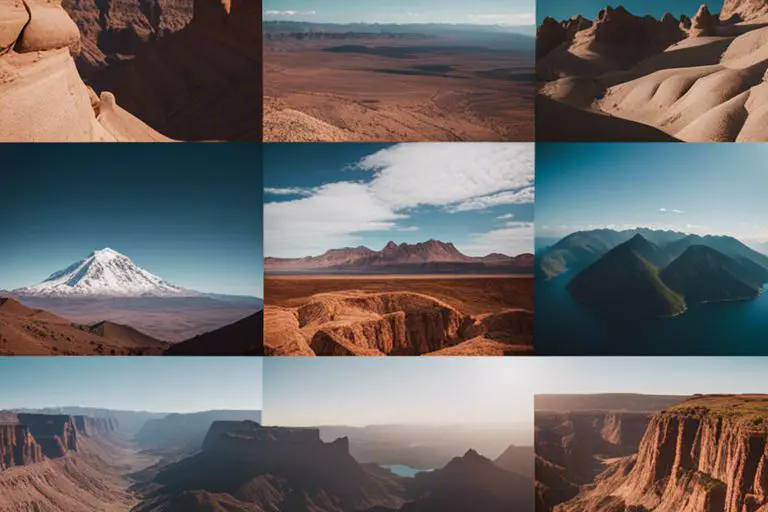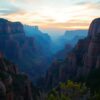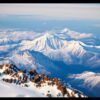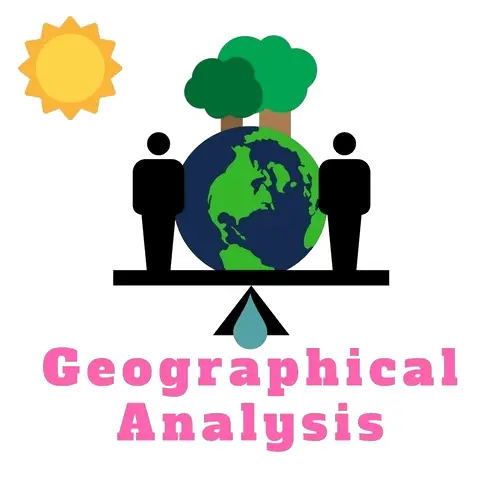Greetings, avid explorers and geology enthusiasts! Today, we embark on a wondrous journey through the unfathomable beauty and geological marvels that our planet has to offer. From the treacherous depths of the Grand Canyon to the majestic peaks of the Himalayas, we will delve into the awe-inspiring landscapes and formations that showcase the incredible forces at work beneath Earth’s surface. Join us as we uncover the fascinating history and extraordinary features of some of the world’s most remarkable landforms, and gain a newfound appreciation for the natural wonders that surround us.
Key Takeaways:
- Earth’s diverse landforms: The Earth is home to a fascinating array of landforms, from towering mountains to expansive deserts, each with its own unique geological processes and formations.
- Geological marvels: The planet is also home to geological marvels such as the Grand Canyon, the Great Barrier Reef, and the Giant’s Causeway, which showcase the incredible power of natural forces over millions of years.
- The importance of preservation: Exploring Earth’s most unique landforms and geological marvels serves as a reminder of the importance of preserving these natural wonders for future generations to enjoy and study.

The Birth of Landforms
Some of the most fascinating features of the Earth’s surface are the result of millions of years of geological processes. These processes have shaped and formed the landforms that we see today, resulting in the diverse and unique landscapes that make up our planet.
Plate Tectonics and Mountain Formation
Formation of mountains is a result of tectonic plates, the massive pieces of the Earth’s crust that float on the semi-fluid mantle beneath them. When these plates move, they can collide, pull apart, or slide past each other. This movement causes the Earth’s crust to buckle and fold, resulting in the formation of mountain ranges.
One of the most well-known examples of mountain formation due to plate tectonics is the Himalayas, where the collision of the Indian and Eurasian plates has created the tallest mountain range in the world – including Mount Everest. This process is slow and ongoing, and it continues to shape the Earth’s surface to this day.
Erosion and Sedimentation Processes
The forces of erosion, such as wind and water, play a crucial role in shaping the Earth’s surface. The wearing away of rock and soil by natural elements creates canyons, valleys, and other unique landforms. Additionally, the deposition of sediments by water, ice, and wind contributes to the formation of new landforms and landscapes.
The Grand Canyon in the United States is a striking example of the power of erosion, as the Colorado River has carved an immense chasm over millions of years. In contrast, the formation of sedimentary rocks, such as limestone and sandstone, through the accumulation and compression of sediments has resulted in stunning geological marvels like the White Cliffs of Dover.
Erosion and sedimentation processes are a natural and ongoing part of the Earth’s geological evolution, shaping the landscape and creating some of the most breathtaking landforms on the planet. These processes, while beautiful and awe-inspiring, can also pose dangers to human settlements and infrastructure, making it important to understand and monitor their impact on the environment.
Volcanic Wonders
To truly understand the incredible geological marvels of our planet, one must explore the fascinating world of volcanic wonders. From the fiery eruptions to the towering mountain peaks, volcanoes have shaped the landscapes of Earth in remarkable ways.
Types of Volcanoes and Their Structures
Volcanoes come in various types, each with its own unique structures and features. Some of the most common types include shield volcanoes, composite volcanoes, and stratovolcanoes. These volcanoes differ in their eruption styles, size, and shapes. Knowing the distinctions between these types is crucial for understanding the behavior and potential hazards associated with each.
| Type of Volcano | Structural Features |
|---|---|
| Shield Volcanoes | Gentle sloping sides, broad and flat summits |
| Composite Volcanoes | Tall, steep-sided volcanoes with explosive eruptions |
| Stratovolcanoes | Large, symmetrical cones with alternating layers of lava and ash |
Famous Volcanic Landforms Around the World
Wonders such as Mount Fuji in Japan, Mauna Loa in Hawaii, and Mount Vesuvius in Italy are just a few examples of the iconic volcanic landforms that have captured the world’s imagination. These majestic wonders showcase the raw power and beauty of volcanic activity, attracting millions of visitors each year.
World travelers and adventure seekers alike are drawn to these awe-inspiring natural attractions, eager to witness the stunning landscapes and learn about the rich geological history of these famous volcanoes. The volatile nature of these landmarks serves as a humbling reminder of the Earth’s extraordinary forces.
Spectacular Erosion Landforms
After exploring the most unique landscapes on Earth, one cannot help but be in awe of the spectacular erosion landforms that have been sculpted over millions of years. These geological marvels showcase the power of erosion and the incredible beauty it has created. For a list of some of the most unusual landscapes in the world, check out 24 of the world’s most unusual landscapes on CNN Travel.
Grand Canyons and River Valleys
With their sheer size and breathtaking beauty, grand canyons and river valleys are some of the most striking erosion landforms on Earth. The Grand Canyon in the United States is a prime example, with its massive expanse and vibrant colors that highlight the layers of rock carved by the Colorado River over millions of years. Other river valleys like the Yangtze River in China and the Colca Canyon in Peru offer equally stunning views and geological insights into the power of erosion.
Otherworldly Arches and Mesas
Spectacular arches and mesas are another stunning result of erosion. These unique landforms can be found in various parts of the world, such as the natural arches of Arches National Park in Utah and the mesas of Monument Valley in the United States. The surreal shapes and vibrant colors of these formations make them a favorite among nature enthusiasts and geology aficionados.
Arches and mesas are not only visually striking, but they also provide valuable insights into the geological processes that have shaped our planet over millions of years. The intricate patterns of sedimentary rock layers and the unique erosional forces at work in these areas make them a must-see for anyone interested in the Earth’s geological history.
Glacial and Periglacial Landscapes
Despite the harsh and unforgiving conditions, glacial and periglacial landscapes have created some of the most breathtaking and unique features on Earth. From towering mountain ranges to vast icy tundras, these landscapes have been shaped by the forces of ice and extreme cold.
Ice-Carved Valleys and Fjords
To witness the majesty of ice-carved valleys and fjords is to behold the true power of glaciers. These imposing landforms are the result of millennia of relentless glacial erosion, carving deep channels into the earth and leaving behind steep, U-shaped valleys and dramatic, cliff-lined fjords that stretch out into the sea. The raw, untouched beauty of these landscapes is a testament to the sheer force of nature at its most formidable.
In addition to their breathtaking beauty, these ice-carved landscapes can also be treacherous, with avalanches, rockfalls, and unpredictable weather posing significant dangers to travelers. However, for those willing to brave the risks, the opportunity to witness these geological marvels up close is an experience like no other, and a reminder of the awe-inspiring power of the natural world.
Permafrost Features and Patterned Ground
Landscapes dotted with permafrost features and patterned ground are a testament to the resilience of life in extreme conditions. The frozen ground of permafrost regions is characterized by unique landforms such as ice wedges, patterned ground, and pingos, which have been shaped by the expansion and contraction of frozen ground over time. These features create a striking, otherworldly landscape that is both beautiful and enigmatic.
The stability of permafrost is crucial for supporting infrastructure in these regions, as thawing permafrost can lead to land subsidence, infrastructure damage, and the release of greenhouse gases. The delicate balance of these landscapes makes them important areas of study for scientists seeking to understand the impacts of climate change on the Earth’s frozen regions.
The preservation of permafrost features and patterned ground is essential for maintaining the delicate balance of these unique landscapes, and the protection of these areas is crucial for the long-term health of the planet. The resilience and adaptability of life in permafrost regions serve as a reminder of the extraordinary diversity and tenacity of life on Earth, even in the most extreme and challenging environments.
Limestone and Karst Topography
Your exploration of Earth’s most unique landforms and geological marvels would not be complete without diving into the world of limestone and karst topography. These formations, characterized by their porous and soluble nature, create some of the most fascinating landscapes on our planet.
Caves and Sinkholes
Caves and sinkholes are hallmark features of limestone and karst topography. Caves are formed as acidic groundwater dissolves the limestone, creating caverns of all shapes and sizes. These underground spaces often house awe-inspiring formations such as stalactites and stalagmites, which we’ll explore in more detail in the next subsection. On the surface, sinkholes can appear suddenly as the ground collapses into underground voids, creating natural pits and depressions. While these features hold a certain allure for explorers, it’s important to remember that their unstable nature can pose danger to both humans and structures.
Tower Karst and Stalactite/Stalagmite Formations
Any discussion of limestone and karst formations would be incomplete without mentioning the majestic tower karst landscapes and the enchanting stalactite and stalagmite formations found within caves. Tower karst, characterized by tall, steep-sided limestone hills, creates dramatic and otherworldly vistas. Inside caves, the slow drip of mineral-laden water creates stalactites hanging from the ceiling, and stalagmites reaching up from the ground, sometimes meeting in the middle to form columns. This process, known as speleothem formation, takes thousands of years and results in some of the most stunning natural sculptures on Earth.
Plus, the porous nature of limestone in karst landscapes allows for the formation of subterranean rivers and streams, contributing to intricate underground drainage systems and even leading to the emergence of freshwater springs on the surface. These natural features play a crucial role in shaping the landscapes they inhabit and provide opportunities for scientific study and recreational exploration.
Exploring Earth’s Most Unique Landforms And Geological Marvels
Considering all points discussed, it is evident that the diversity and complexity of Earth’s geological marvels are truly astonishing. From the towering peaks of the Himalayas to the intricate formations of the Antelope Canyon, the planet’s landforms offer a wealth of beauty and wonder for those willing to explore them. By understanding the processes that shape these unique features, we gain a deeper appreciation for the forces that have shaped and continue to shape our world. Whether it be the result of tectonic activity, erosion, or volcanic eruptions, each landform tells a story of Earth’s dynamic and ever-changing landscape. As we continue to study and appreciate these wonders, we can better comprehend and protect the delicate balance of natural processes that have created such diverse and awe-inspiring geological formations.
FAQ
Q: What are some examples of unique landforms and geological marvels to explore on Earth?
A: Some examples include the Grand Canyon, the Great Barrier Reef, Mount Everest, the Giant’s Causeway, and the Great Blue Hole. Each location offers breathtaking natural beauty and a glimpse into Earth’s geological history.
Q: How were these unique landforms and geological marvels formed?
A: These landforms and marvels were formed through a variety of geological processes such as erosion, volcanic activity, tectonic plate movement, and the forces of nature over millions of years. The Grand Canyon, for example, was carved by the Colorado River over millions of years, while the Great Blue Hole formed through the gradual rise in sea levels during past ice ages.
Q: What are some safety considerations when exploring these unique geological sites?
A: It is important to follow all safety guidelines and regulations when exploring these sites, as they can present potential hazards such as steep cliffs, unstable ground, or extreme weather conditions. It is also crucial to respect the natural environment and wildlife, and to be mindful of any conservation efforts in place to protect these unique landforms and geological marvels.







